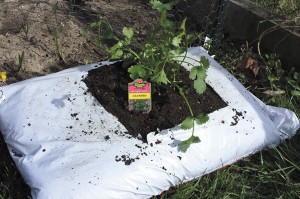Are you ready to put away the snow shovels for the garden spade? Yeah, we are, too.
“Snow is the poor man’s fertilizer” isn’t just an old gardening trope — there is actually science behind it! My grandfather the orchardsman loved to see snow on his cornfields all winter long, as he was convinced it made the corn sweeter. Grandpa knew his business deep in his bones, as scientific studies show that the white stuff does contribute to plant health. When snowflakes form, they absorb nitrates from the atmosphere and release nutrients when they hit the ground and melt. Studies suggest that a good cover of snow can contribute 5-10 lbs. of nitrates to an acre of soil. So you see, a late-season mini-blizzard can be a good thing down the road.
April is the month everyone gets antsy and plants too early, or realizes they should have started their seeds two weeks ago. The last average freeze date in Central Indiana is April 17(ish) but everyone knows it isn’t really safe to plant outdoors until Mother’s Day, or mid-May. April is best spent cleaning up what you forgot to do in March and making your plans for the months to come. Don’t be tempted by all the pretty plants set out at the big box stores on warm weekends — as soon as you buy them, we’ll get a cold snap and you’ll be back to replace them, sadder but wiser.
Lazy gardeners thinking about a few vegetables or flowers can look into grow bags at your friendly local garden supply store. Grow bags have been around for a long time, and are made of a tough fiber that allows air to circulate and water to drain. They come in a variety of sizes, from 1 gallon up to 20 gallons. Last year, I planted two 15 gallon bags with carrots and had a very nice harvest. The larger bags are great for potatoes, carrots, peanuts, and sweet potatoes. Shallow bags are available online at a variety of sites as well as your local stores — those are best for shallow-rooted plants, and perhaps cascading flowers. Most of the grow bags are not the prettiest things in the world, so trailing flowers and greenery will hide the black or brown bags. Another downside is you have to buy garden soil to put in them, and the big ones are hard to move once full. Empty them at the end of the season and put them in a dry place to prolong their lives.
An even more unattractive, but effective, lazy gardening tip is the topsoil/compost bag method. I’ve used this very effectively for years when I ran out of space in the Mother of All Gardens (MAG for short) and had just a few more plants I needed/wanted to grow. Take a 40 lb. bag of topsoil/garden soil, available at any big box store or garden center, and flop it down (see picture). Poke drainage holes in it, then flop it over again. Using your handy utility knife, cut an “X” in the middle large enough for the seedling you want to plant, and tuck the “v” parts under. Add fertilizer, dig a hole for your plant, and there you have it. No weeding is required — just remember to water it more during dry periods. At the end of the gardening season, you can roll the bag into your regular garden and slit it open to build up more soil.
Obviously, you won’t be able to grow deep-rooted plants in the bags, but for most herbs and flowers, this way works just fine. The downside is that the bags aren’t especially attractive, so hiding them from the fussy neighbors might be in order.



